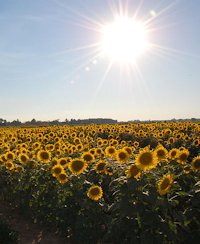
|
Some Common Myths Thought to be True - Myth 53
Myth 53: Sunflowers Track the Sun with their Blooms
A common misconception is that flowering sunflower heads track the Sun across
the sky. Although immature flower buds exhibit this behaviour, the mature
flowering heads point in a fixed (and typically easterly) direction throughout
the day. This old misconception was disputed in 1597 by the English botanist
John Gerard, who grew sunflowers in his famous herbal garden: "[some] have
reported it to turn with the Sun, the which I could never observe, although I
have endeavored to find out the truth of it." The uniform alignment of
sunflower heads in a field might give some people the false impression that the
flowers are tracking the sun.
|
| Flower heads facing East, away from the Sun. Late afternoon, Sun is in the West. | |
|
The sunflower (Helianthus annuus) is an annual plant native to the Americas. It
possesses a large inflorescence (flowering head), and its name is derived from
the flower's shape and image, which is often used to capture the sun. The plant
has a rough, hairy stem, broad, coarsely toothed, rough leaves, and circular
flower heads. The heads consist of many individual flowers which mature into
seeds, often in the hundreds, on a receptacle base. From the Americas,
sunflower seeds were brought to Europe in the 16th century, where, along with
sunflower oil, they became a widespread cooking ingredient. Leaves of the
sunflower can be used as cattle feed, while the stems contain a fibre which may
be used in paper production.
|
|
| ⇦ Back to Myth 52 Return to Myth Choices Page 4 On to Myth 54 ⇨ | |